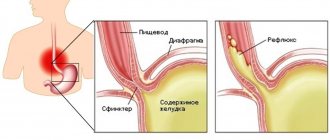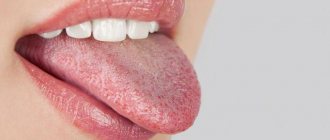Arsenyev Alexey Olegovich
Vascular surgeon, phlebologist, Ultrasound doctor
October 25, 2021
Of course, subcutaneous hemorrhage or bruising on the body can look unsightly and cause aesthetic discomfort. If this is an isolated situation, then, as a rule, there is nothing wrong with it. If the situation repeats: bruises occur in different places and, perhaps, complaints appear in other organs and systems (for example, pain in the heart, joints), then you should figure out why the vessels burst on the legs or body, as this may be a manifestation one of the more serious pathologies.
Bloody marks on the tongue - what can cause the symptom and what to do about it
There are many possible reasons why your tongue may bleed. Most often, the prerequisite for this unpleasant phenomenon is banal damage to the organ during talking or chewing. However, in other cases, this symptom may indicate serious health problems. Such manifestations as a thick coating on the tongue, enlarged papillae, and even more so traces of blood, should at least alert you and also become a good reason to contact a specialist. Today we will look at the most common causes of blood above and below the tongue, and also find out what to do with this symptom.
Structure and purpose of the language organ
The tongue is a digestive organ. Essentially, this is a muscle that consists of striated tissue. It is covered with a protective layer - the mucous membrane. The anatomical structure of the organ includes two parts: the body and the root. The upper region is called the back, and under the organ is the frenulum. There are also terminal and longitudinal grooves - the first is located at the junction of the root and the body, and the second divides the organ vertically.
On a note! On the surface of the tongue there are many papillae, which contain taste buds. For example, those responsible for recognizing sweet taste are located on the tip, and salty taste is located on the sides. On the side, closer to the root, there are receptors that react to sour things, but the base of the organ is susceptible to bitter tastes.
The tongue not only allows us to enjoy the taste of our favorite treats, but also takes a very direct part in the conversational function. It also helps us chew food and is responsible for the production of salivary fluid, which, in turn, helps break down food particles and therefore participates in digestion.
Why might your tongue bleed?
Now let's figure out why blood still appears on the tongue. There are many potential causes of blood marks, but the most common is careless biting of an organ while speaking or chewing. Most often the tip suffers for this reason. As a result, painful ulcers may form on the surface of the epithelium. The choice of a specific treatment method in this case will directly depend on the extent of the damage. If the wound is small, but there is bleeding, it will be enough to treat the defect with an antiseptic solution. However, before using a pharmaceutical product, you should consult your doctor.
Why does the tongue bleed?
If the wound is serious and requires stitches, then you cannot do without the help of a specialist. In addition to banal biting, there are many other reasons that can lead to bleeding. Let's take a closer look at them.
Causes
Among the factors that provoke various external damage to the oral mucosa are:
Mechanical
Injury to the surface of the tongue is caused by all piercing and cutting objects that cause direct and instantly noticeable harm.
For example, dishes with bones cause damage to the oral mucosa during consumption. It is not the amount of food eaten that matters here, but the receipt of microtraumas that violate the integrity of the surface of the tongue.
Blood blisters that form due to mechanical action do not pose any threat to human health. To speed up the process of resorption of seals on the tongue, under it, it is recommended to rinse the mouth more often after eating.
Chemical
The duration of wound healing from thermal exposure directly depends on the depth of the lesion; they heal for quite a long time
When eating salty or sour food in the mouth, small lesions in the form of ulcers appear almost instantly on the mucous membrane of the tongue.
This reaction is observed among most fans of oriental cuisine, where hot seasonings are used.
Thermal
Such damage includes microtraumas resulting from drinking too hot tea or coffee.
The duration of wound healing from thermal exposure directly depends on the depth of the lesion; they take quite a long time to heal.
Depending on the degree of damage, sensations change:
- In the first degree, the burn occurs only on the outer layer of the tongue. A person experiences pain, the color of the tongue changes to red and after some time begins to swell. Rinsing the mouth with antiseptic solutions will help speed up the healing process.
- In the second degree , the sensations become more painful, since not only the outer but also the inner layer of the tongue is affected. The formation of blood blisters, swelling of the tongue and its redness are also observed. In this case, it is recommended to seek medical help as soon as possible so that the doctor removes the lump, washes the affected area and treats it with an antiseptic.
- In the third degree, the burn penetrates deep into the tongue, the burned surface becomes black. The patient complains of a feeling of numbness of the tongue and severe pain. The help of a doctor is mandatory here, otherwise there is a high probability of death.
Mechanical causes of bleeding
As noted above, the most common cause of blood is mechanical damage. However, this phenomenon is not always caused by careless tongue biting. The oral mucosa can be damaged as a result of careless cleaning of the tongue, injury from a sharp nut shell, seed or fish bone. It’s even more difficult with babies, because when children start teething, they diligently put everything they can get their hands on into their mouths. At this time, the risk of soft tissue injury increases significantly.
“For example, it used to often happen to me that I wake up in the morning and blood is flowing from my tongue. It doesn’t whip, of course, but still. True, after brushing my teeth everything went away. And then I finally decided to get braces and went to see an orthodontist. While talking to the doctor, I told her about my problem, and then she explained that it was all due to an incorrect bite and crooked teeth. It’s just that at night, when I involuntarily clenched my jaws, my teeth began to rub my tongue, which then caused bleeding. Now I’m in braces, which, by the way, also seriously scratched all the mucous membranes, but here wax saves me ... "
Camilla R., 28 years old, from correspondence on the forum www.32top.ru
Tongue injury is a common cause of bleeding.
Other common external factors include a fall or blow to the face. At high risk are people with damaged teeth, the sharp edges of which can easily damage the integrity of soft tissues. Also, many problems are caused by incorrectly installed fillings, worn-out prosthetic structures that require relining or replacement, as well as orthodontic devices, which contain many small parts that can injure surrounding tissues.
I would like to pay special attention to hematomas that form directly on the body of the tongue as a result of mechanical influences. A bruise appears when a vessel located inside an organ bursts. This situation can lead to swelling of the soft tissues, which can lead to difficulty breathing and other serious consequences.
Causes of intradermal hemorrhages
- Domestic injury
Living under time pressure, a person is constantly in a hurry to get somewhere and sometimes does not notice how in the course of his actions he receives some minor injuries or bruises. There is a direct cause-and-effect relationship in this: injury - damaged/burst vessels in the legs - bruise. There will be no injuries - there will be no hemorrhages.
- Phlebeurysm
With this disease, moderate venous hypertension is created in the superficial venous system due to valve incompetence and the formation of blood stagnation in the veins. Along with this, there is already an overstretched, swollen vein (varix - from the Latin swelling), the wall of which becomes thinner (analogy: the more we inflate a balloon, the more likely it is to burst), at some point it cannot stand it and bursts. Therefore, if a vein is swollen in the temple, leg or body, then you need to contact a vascular surgeon/phlebologist. And together with the doctor, plan treatment - from simple lifestyle modification to surgery to remove large veins.
- Non-physiological loads
A modern girl can walk or stand in high heels for 8–10 hours a day, which, in turn, leads to a significant weakening of the mechanisms of venous blood outflow and an increase in venous pressure, hypertension in the legs. This may contribute to the appearance of a bruise. The best solution in this situation is to give up heels or at least reduce the duration of wearing them, increase the volume of dynamic load, which also helps venous outflow.
- Taking hormonal medications containing female sex hormones (including oral contraceptives)
The reason for prescribing hormonal drugs may be banal contraception, treatment of gynecological, dermatological or other group of diseases. These drugs contain female sex hormones, which, in addition to regulating the cycle and the formation of secondary sexual characteristics in women, also affect the vascular system: they provoke bruises on the legs, the vessels become brittle, their elasticity decreases, and the diameter of the veins increases. The decision to discontinue, replace the drug and treat increased vascular fragility is made only after an in-person examination of the patient and review of the medical history. In this case, therapy is carried out by gynecologists, vascular surgeons/phlebologists.
- Condition after respiratory infections
Most viruses (influenza, parainfluenza, coronavirus infection, ARVI) are tropic to vascular structures, and after a person has had one of them, bruises may appear on the body that were not there before. In this situation, the body needs to be given time to recover; you can also include in your diet foods rich in vitamin C (citrus fruits, kiwi, rose hips, sea buckthorn, black currants, parsley, broccoli, sweet red peppers, sauerkraut, etc.), vitamin P ( citrus fruits, buckwheat, black currants, rose hips, raspberries, tomatoes, beets, red bell peppers, asparagus, plums, etc.). It is possible to take synthetic analogues of these drugs, but before doing so, you must see a doctor.
- Vasculitis
A group of diseases that is accompanied by inflammation of the vascular wall, and sometimes by its increased permeability and fragility.
Vasculitis is divided into several types:
- Primary is an independent process in the vascular system, and not a consequence of the pathology of other organs. The group of primary vasculitis, accompanied by the appearance of bruises, includes: Wegener's granulomatosis, Churg-Strauss syndrome, microscopic polyangiitis, Henoch-Schönlein purpura, hypersensitivity vasculitis, cryoglobulinemic vasculitis, Behçet's disease, vasculitis in rheumatic diseases (systemic lupus erythematosus, rheumatoid arthritis, Sjögren), etc. In such cases, etiotropic therapy of the pathology, that is, treatment of the underlying cause, is carried out by a rheumatologist, and vascular surgeons/phlebologists, cardiologists, and dermatologists help treat the consequences of the disease.
- Secondary - there is another disease (oncological or infectious origin), against the background of which hemorrhages appear on the skin. One example is vasculitis against the background of exacerbation of viral hepatitis. This also includes the previously mentioned respiratory infections. With effective treatment of the underlying disease, bruising on the body disappears.
Pathological causes of bleeding
Why else might bloody marks appear on the tongue? There are a number of potential pathological causes for this symptom, but the most common condition in this case is glossitis. It is this disease that leads to the appearance of traces of blood on the organ, and it develops for several reasons:
- entry of harmful microorganisms into an open wound,
- allergies to hygiene products,
- exposure to chemicals, acrid tobacco smoke or low quality alcohol,
- frequent consumption of spicy and acidic foods.
The photo shows glossitis of the tongue.
The spread of infection into soft tissues sometimes leads to the appearance of cracks, blisters and bleeding ulcers. Such neoplasms can also result from disturbances in the functioning of the gastrointestinal tract and central nervous system. By the way, cracks very often become an allergic reaction or the result of a deficiency in the body of vitamins B, A, PP1.
What is a blood blister on the tongue?
What does it look like?
It is an accumulation of coagulated blood in an organic cavity under the mucous membrane
A blood blister is also called a hematoma, blood blister, or lump.
It is an accumulation of coagulated blood in an organic cavity under the mucous membrane.
On the tongue, a hematoma looks like a swelling, the color of the tongue changes and becomes bluish, and swelling appears.
The patient feels pain and discomfort while eating and talking.
In addition, pinpoint hemorrhages are often observed on the mucous membrane.
The appearance of bloody bumps is a kind of hemorrhage that occurs as a result of injury to the capillaries and thin vessels of the oral mucosa.
Inside the bladder there may be a clear serous fluid without blood impurities, which indicates that the vessels are not intact and have not been damaged. Such hematomas are superficial in nature and the healing process occurs very quickly.
If a hematoma on the tongue contains blood inside, then the injury is deep and its healing period will be much longer until the blood resolves.
How does a blood blister form?
At the moment of microtrauma, harmful microorganisms begin to attack the damaged area
Bloody blisters in the mouth often do not pose a serious threat to human health.
They arise as a result of mechanical damage to the mucosa.
At the moment of microtrauma, harmful microorganisms begin to attack the damaged area.
To destroy them in the body, immune forces begin to activate.
Leukocytes and monocytes, macrophages are immediately sent to the injured area, which suppress the vital activity of microbes and eliminate them.
Important! Considering that a blood lump in the mouth is only part of the body’s defense reaction, it goes away quite independently after 7 days. If this does not happen, then it is recommended to visit a qualified specialist who can establish the correct diagnosis and prescribe the appropriate treatment regimen. This measure is necessary to exclude serious diseases in the body and neoplasms.
The level of health of the body is assessed according to the general condition and integrity of the oral mucosa, and only upon examination can a final diagnosis be made.
Since the clinical manifestations of many pathological conditions, including infectious, chronic, bacterial, occur along with a change in the color and integrity of the oral mucosa (tongue, gums). Here it is important to identify the true cause of the blood ball.
Localization
Appearing hematomas indicate microtrauma that has occurred.
Blood blisters are distinguished by their location. They can be on the surface of the tongue, under it and on the cheeks.
The appearance of hematomas indicates that microtrauma has occurred or the presence of a serious pathological condition.
A large number of blisters on the oral mucosa, filled with blood, can form due to diseases of the gastrointestinal canal, dental problems, and disturbances in the functioning of the endocrine system.
So, with stomatitis, blisters and ulcers appear on the mucous membrane of the cheeks, on the gums, and on the palate, as well as on the tongue.
With syphilis, blood bumps are located on the tip, back of the tongue or on its lateral surfaces. With tuberculosis, hematomas are localized on the tongue, lips, cheeks, gums, and palate.
Treatment of bleeding
What to do if bleeding comes from the tongue, and how to quickly stop it? First of all, it should be noted that treatment here will directly depend on the cause of the problem and the extent of the injury. To reduce bleeding and relieve pain, dental experts advise you to adhere to the following recommendations:
- first you need to thoroughly wash your hands and treat them with an antiseptic, for example, wipe them with alcohol or a special pharmaceutical solution. You can also use sterile gloves. The most important thing is not to allow infection to enter the open wound,
- after this, you should go to the mirror, tilt your head slightly forward to prevent blood from flowing down your throat and obstructing your breathing. It is imperative to remove all foreign objects from the oral cavity: chewing gum, piercings, dentures, if any,
- To stop the bleeding, you will have to put a little pressure on the organ. To do this, you will need a clean bandage, gauze or cotton wool, which must be applied to the damaged area. You need to keep the napkin in this position for at least 10 minutes. The tongue is characterized by an intense blood supply, so coping with the problem will not be difficult. After the specified time has passed, you need to remove the napkin and make sure that the blood has stopped flowing,
- After this, you need to rinse your mouth with cool water - cold causes blood vessels to constrict. Only after this can treatment be carried out with an antiseptic.
To stop bleeding, you need to cover the wound with a bandage.
If your tongue hurts a lot, try applying a piece of ice wrapped in sterile gauze to the wound. To alleviate the condition, you can take a painkiller tablet. If the wound is quite deep, be sure to go to the doctor.
What you should absolutely not do
If blood appears on the tongue, it means there is an open wound on its surface. In order not to aggravate the situation and not provoke the development of inflammatory processes, it is important to adhere to some restrictions. So, if you inadvertently injured the main speech organ, refrain from the following actions:
- cauterizing the wound with alcohol - this will only further injure the mucous membrane,
- drinking hot tea will increase bleeding,
- treating the wound with brilliant green or iodine,
- pressing the wound with a bare finger or teeth, trying to stop the bleeding by pressing the tongue to the roof of the mouth.
Until the bleeding has completely stopped, do not eat or put anything foreign in your mouth until the wound has completely healed. It is also strictly forbidden to self-medicate with antibacterial drugs - they can only be prescribed by the attending physician.
How to treat a blood bladder?
General therapy
Depending on the type of pathological condition that caused the appearance of a blood bubble in the mouth, treatment can be carried out with the following medications:
- In case of traumatic formations that go away on their own over time, the oral cavity is treated with antiseptic agents
For candidal stomatitis, antifungal drugs such as Levorin and Nystanin are effective.
- For diseases of viral etiology, the treatment regimen includes Viferon, Amoxicillin, Tsiprolet, Azithromycin.
- To combat gingivostomatitis, where it is expected to remove areas affected by necrosis, antiallergic medications, antibacterial agents, and vitamin complexes are used.
- In case of traumatic formations that go away on their own over time, the oral cavity is treated with antiseptic agents. If there is pain, the doctor may prescribe Cholisal, Ketoprofen, Voltaren, Lornoxicam, Kamistad.
- To eliminate tuberculosis, appropriate chemotherapy is prescribed, which includes Rifampicin, Ioniazid, Pyrazinamide.
Local therapy
To speed up the healing process, regularly rinse with antiseptic agents. Furacilin, Chlorhexidine, Stomatidine, Betadine, Miramistin, hydrogen peroxide solution, Iodoform, Chlorophyllipt show good results.
Treatment of the affected tongue with disinfectant solutions should be performed twice a day, at a minimum, but before that you must brush your teeth and remove any remaining food.
It is advisable to eat food after the procedures within 30-60 minutes, which will significantly increase their effectiveness.
Traditional methods
Aloe or Kalanchoe juice has a wound healing effect
To alleviate the condition, it is good to use healing decoctions based on chamomile, sage, yarrow, St. John's wort, and viburnum fruits.
They are prepared at the rate of 1 tbsp. herbal raw materials per 1 glass of water.
The mixture is brought to a boil and left for 2-3 hours to infuse. Before use you need to strain.
Aloe or Kalanchoe juice has a wound-healing effect.
Oil from sea buckthorn and rosehip also has the same property. They are applied directly to the affected area.
These agents accelerate the regeneration process, prevent the proliferation of pathogenic microorganisms and anesthetize the lesion.
A solution prepared from salt (1 tsp), 3 drops of iodine and soda (1 tsp) is a universal remedy in the fight against inflammatory processes in the oral cavity.
These components are mixed in one glass of warm boiled water and used for lotions and rinses. It is also good to treat the affected areas with hydrogen peroxide.
When to see a doctor
In some situations, there may be a need for emergency assistance from a specialist. You should consult a doctor if you cannot stop the bleeding on your own, and if there is severe swelling of the soft tissue in the area of injury. A hematoma has appeared on the tongue, pharmaceutical products do not help cope with severe pain, and pus begins to leak from the wound - all this is a serious reason for concern and an urgent visit to the doctor.
If pus appears, you should definitely contact a specialist.
You should also definitely visit a dentist if, some time after the injury, a thick coating with obvious grooves begins to form on the tongue, and there is a burning sensation and discomfort when eating. Remember: a consultation with a specialist is never superfluous, especially if we are talking about an open wound on the oral mucosa.
- Gorbacheva I.A., Integrated approaches to the treatment of patients with combined diseases of internal organs and inflammatory periodontal lesions, 2004.
What not to do?
If you have blood blisters, you should not:
- Pierce and burst them yourself. This technique will only worsen the situation; as a result of additional injury, a fungal infection will join the existing problem, which will prolong the disease.
- Ignore the hematoma, lump, or clot that appears in the oral cavity. If there are any changes in the mucous membrane of the tongue, gums, palate, or cheeks, it is recommended to contact a qualified specialist who will identify the true cause of the disease and prescribe an appropriate treatment regimen.









